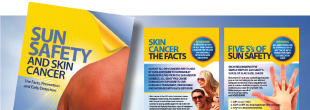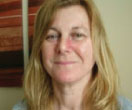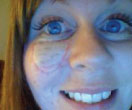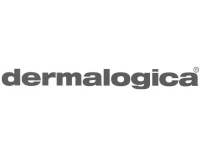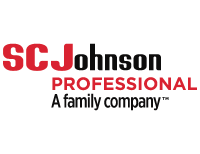
RAISING AWARENESS THROUGH EDUCATION
PROMOTING PREVENTION & EARLY DETECTION CAMPAIGNING FOR CHANGE
SKCIN: THE KAREN CLIFFORD SKIN CANCER CHARITY / REGISTERED CHARITY: 1150048

WE NEED YOUR HELP! PLEASE HELP US TO STOP SKIN CANCER TAKING MORE LIVES. WE ARE HUGELY GRATEFUL FOR YOUR SUPPORT.
Are You At Risk?
Skin Cancer Information
All skin types can be damaged by UVR, but some skin types
and family history of skin cancer can mean you are more at risk

Skin cancer is the UK’s most common and fastest rising cancer.
It is now one of the biggest cancer killers in 15-34 year olds.

Solar Ultra Violet Radiation (UVR) is a known carcinogen.
It cannot be seen or felt and is the primary cause of skin cancer

Sunburn is a reaction to UV radiation and is a clear sign that
you have seriously damaged your skin.

Sunbeds are not safe - FACT! UV radiation from sunbeds can
cause serious and irreparable damage and cause melanoma

Worried about Vitamin D? Know the facts and how much sun
we need to produce the required daily levels.

Our skin is our body’s largest organ that performs a variety of
vital functions - learn how UVR affects and damages our skin
Skin types and risk of skin cancer.
Your skin type is a major contributing factor to your risk of sun damage and developing skin cancer. Certain types of skin are at greater risk of sun damage and therefore at greater risk of developing the disease. It is important however to acknowledge that all skin types can be damaged by over-exposure to UV radiation and therefore to varying degrees we are ALL at risk of developing skin cancer. However, generally, those with fairer skin that is more susceptible to burning are at greater risk.
Skin colour is dependent on a pigment called melanin. This is produced by specialised cells called melanocytes. Melanocytes are found throughout the skin. All races have the same number of
melanoctyes. Black skin, however, has more melanosomes, giving better sun protection and more pigmentation. Melanin protects your skin by absorbing harmful UV radiation and it darkens when doing so, producing pigmentation and leaving you with what we call a sun tan.
There are six different skin phototypes ranging from very fair to very dark skin. Individuals with skin types 1 and 2 are at greater risk of developing skin cancer because fairer skin has less pigmentation which provides less natural protection and burns more easily - causing damage to skin cells that can lead to skin cancer. Skin types 5 and 6 are at the lowest risk as they have a greater amount of pigmentation that provides more natural protection from UV, but they are still at risk.
Do you know your skin type?
Click on the skin type classification below to that best matches your own skin to find out more about your level of associated risk and what you should do to prevent skin cancer.
SKIN TYPE 1
This skin type typically always burns and never tans in the sun.
This skin type is therefore extremely susceptible to skin damage and the development of skin cancers such as basal cell carcinoma, squamous cell carcinoma and melanoma - the deadliest form of skin cancer.
It is hugely important that individuals with this skin type:
- Always use sun protection measures and follow the Five S's of Sun Safety
- Use a minimum SPF 30+, broad spectrum sunscreen
with maximum UVA protection and reapply at least every 2 hours. - NEVER allow themselves to burn
- Check their skin at least once a month for signs of change
- Seek professional advice with ANYTHING suspicious
- Have an annual professional screening
SKIN TYPE 2
This skin type typically often burns and rarely tans in the sun. This skin type is is therefore highly susceptible to skin damage and the development of skin cancers such as basal cell carcinoma, squamous cell carcinoma and melanoma - the deadliest form of skin cancer. It is hugely important that individuals with this skin type:
- Always use sun protection measures and follow the Five S's of Sun Safety
- Use a minimum SPF 30+, broad spectrum sunscreen with maximum UVA protection and reapply at least every 2 hours.
- NEVER allow themselves to burn
- Check their skin at least once a month for signs of change
- Seek professional advice with ANYTHING suspicious
- Have an annual professional screening
SKIN TYPE 3
This skin type sometimes tans and sometimes burns in the sun. This skin type is therefore susceptible to skin damage and the development of skin cancers such as basal cell carcinoma, squamous cell carcinoma and melanoma - the deadliest form of skin cancer. It is important that individuals with this skin type:
- Always use sun protection measures and follow the Five S's of Sun Safety
- Use a minimum SPF 30+, broad spectrum UVA protection sunscreen
- NEVER allow themselves to burn
- Check their skin at least once a month for signs of change
- Seek professional advice with ANYTHING suspicious
- Have an annual professional screening
SKIN TYPE 4
This skin type typically tans easily and is less likely to burn This skin type is however still at risk of developing skin cancer It is important that individuals with this skin type:
- Use sun protection measures and follow the Five S's of Sun Safety
- Use an SPF 30+, broad spectrum UVA protection sunscreen
- Check their skin at least once a month for signs of change
- Seek professional advice with ANYTHING suspicious
- Have an annual professional screening
SKIN TYPE 5
This skin type typically tans easily and rarely burns This skin type is at lower risk, but still can develop skin cancer and arcal lentiginous melanoma which is common among darker-skinned individuals. These melanomas typically appear on areas of the body that have not been exposed to the sun and all-too-often remain undetected until after the cancer has spread to other body parts. It is important that individuals with this skin type:
- Use sun protection measures and follow the Five S's of Sun Safety
- Check their skin at least once a month for signs of change
- Always check palms of hand, soles of feet and mucous membranes
- Seek professional advice with ANYTHING suspicious
- Have an annual professional screening
SKIN TYPE 6
This skin type typically does not burn in the sun, This skin types is still at risk of skin cancer and developing arcal lentiginous melanoma which is common among darker-skinned individuals. These melanomas typically appear on areas of the body that have not been exposed to the sun and all -too-often remain undetected until after the cancer has spread to other body parts. It is important that individuals with this skin type:
- Use sun protection measures and follow the Five S's of Sun Safety
- Check their skin at least once a month for signs of change
- Always check palms of hand, soles of feet and mucous membranes
- Seek professional advice with ANYTHING suspicious
- Have an annual professional screening
Family history of Melanoma
If you have a close relative who has had melanoma, you are more at risk yourself. Around 5% of
melanoma patients in the UK report a family history. This is probably because we tend to share the same sort of colouring and skin type as our close relatives. But nevertheless, even if you are darker
in colouring, you should be more careful about the sun.
Some families tend to have large numbers of moles (most people have about 10 to 40 moles), or moles that are unusual (doctors call them "atypical"). The "atypical" moles tend to be an
irregular shape or colour and occasionally can become malignant, people with moles like this have a higher than average risk of melanoma and it is important that these people examine their moles on a monthly basis so that they know them and can spot a change. The highest risk factor known for melanoma is to have a very close relative (parent or brother or sister) with melanoma and to have abnormal looking moles yourself. People who have a dysplastic naevus and who have two or more first-degree relatives with melanoma may be at 100 times the risk of developing melanoma. It is essential that those at high risk are vigilant in protecting their skin form the effects of the sun, please See Sun Protection for more information.
Scientists think that around 1 in 10 cases of melanoma may be linked to inherited faulty genes. Two of these genes have been identified and Cancer Research UK researchers are very close to identifying a third. For the small number of families who carry these genes, sun protection is even more important.
Sunbed users are at a greater risk of developing skin cancers
and melanoma - the deadliest form of the disease...
Using sunbeds for the first time before the age of 35 increases the risk of developing melanoma skin cancer by 59%. Regular sunbed use under the age of 30 increases the risk of skin cancer by an alarming 75%! Short, intense and irregular UV exposure, like you receive from sunbed
use is the fastest way to damage your skin. Damage increases with each session, is irreparable and can lead to melanoma - one of the biggest cancer killers in 15-34 year olds in the UK!
Learn more about the risks of indoor tanning >
You may also be interested in the following related topics:
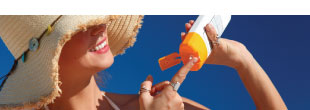
the golden rules of sun safety
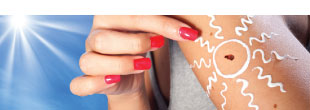
what you should be looking for...

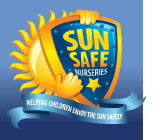
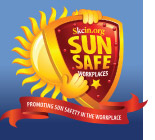
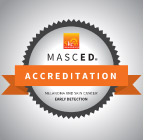
Articles of interest
SIG ROOFING PARTNERS WITH SKCIN
Aptly timed during skin cancer awareness month, National roofing merchant SIG Roofing has announ...
28th May 2024 3:05pm
SKCIN, a charity that specialises in the prevention and early detection of skin cancer through educational interve...
1st May 2024 12:39pm
AHEAD OF NATIONAL SKIN CANCER AWARENESS MONTH IN MAY, BRITISH BEAUTY BACKS VAT BURN CAMPAIGN AMIDST SKIN CANC...
26th Apr 2024 2:16pm
SUNAK WARNED MELANOMA CASES WILL INCREASE WITHOUT GOVERNMENT ACTION
Skcin are proud to support SNP MP Amy Callaghan with her on-going VAT Burn Campaign as she...
28th Nov 2023 12:20pm
SKCIN are delighted to highlight a positive initiative by New College Lanarkshire in Motherwell. The college is supporti...
22nd Jun 2023 1:05pm
